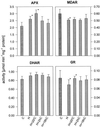Re-Aeration following Hypoxia or Anoxia Leads to Activation of the Antioxidative Defense System in Roots of Wheat Seedlings
- PMID: 9490765
- PMCID: PMC35123
- DOI: 10.1104/pp.116.2.651
Re-Aeration following Hypoxia or Anoxia Leads to Activation of the Antioxidative Defense System in Roots of Wheat Seedlings
Abstract
The response of the ascorbate-glutathione cycle was investigated in roots of young wheat (Triticum aestivum L.) seedlings that were deprived of oxygen either by subjecting them to root hypoxia or to entire plant anoxia and then re-aerated. Although higher total levels of ascorbate and glutathione were observed under hypoxia, only the total amount of ascorbate was increased under anoxia. Under both treatments a significant increase in the reduced form of ascorbate and glutathione was found, resulting in increased reduction states. Upon the onset of re-aeration the ratios started to decline rapidly, indicating oxidative stress. Hypoxia caused higher activity of ascorbate peroxidase, whereas activities of monodehydroascorbate reductase, dehydroascorbate reductase, and glutathione reductase were diminished or only slightly influenced. Under anoxia, activities of ascorbate peroxidase and glutathione reductase decreased significantly to 39 and 62%, respectively. However, after re-aeration of hypoxically or anoxically pretreated roots, activity of enzymes approached the control levels. This corresponds with the restoration of the high reduction state of ascorbate and glutathione within 16 to 96 h of re-aeration, depending on the previous duration of anoxia. Apparently, anoxia followed by re-aeration more severely impairs entire plant metabolism compared with hypoxia, thus leading to decreased viability.
Figures



References
-
- Albrecht G, Kammerer S, Praznik W, Wiedenroth EM. Fructan content of wheat seedlings (Triticum aestivum L.) under hypoxia and following re-aeration. New Phytol. 1993;123:471–476. - PubMed
-
- Albrecht G, Wiedenroth EM. Protection against activated oxygen following re-aeration of hypoxically pre-treated wheat roots. The response of the glutathione system. J Exp Bot. 1994;45:449–455.
-
- Aono M, Kubo A, Saji H, Tanaka K, Kondo N. Resistance to activated oxygen toxicity of transgenic Nicotiana tabacum that expresses the gene for glutathione reductase from Escherichia coli. Plant Cell Physiol. 1991;32:691–697.
-
- Asada K. Ascorbate peroxidase—a hydrogen peroxide-scavenging enzyme in plants. Physiol Plant. 1992;85:235–241.
LinkOut - more resources
Full Text Sources

